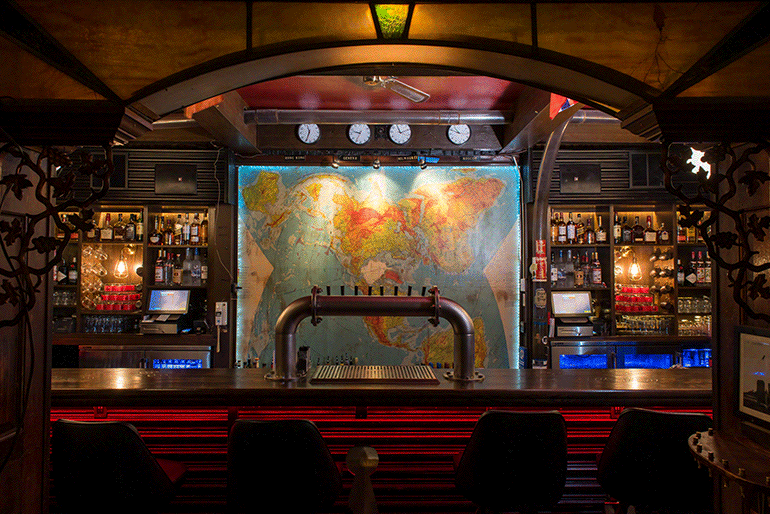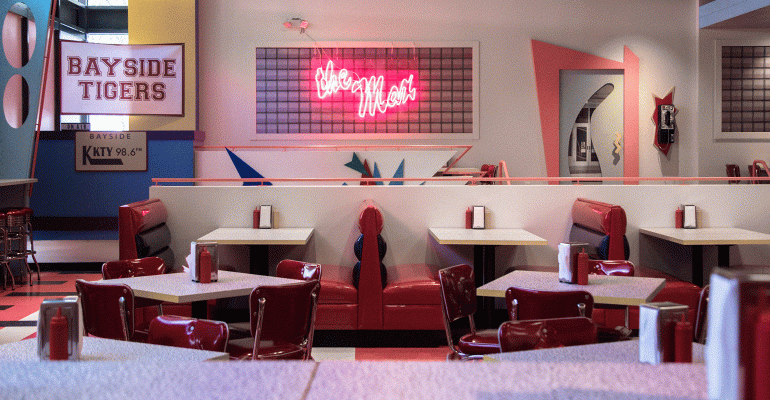Restaurants filled with pop-culture memorabilia, kitschy menus and gift shops were a driving force of dining trends in the 1980s and early 1990s. Part tourist attraction and part dining establishment, it seemed theme restaurants were everywhere.
Then, as consumer tastes changed and people began valuing food quality over tableside entertainment, theme restaurants started to close their doors. Even popular chains like The Rainforest Café and Planet Hollywood struggled to stay relevant.
Gary Stibel, CEO of The New England Consulting Group, estimated that over the past two decades, the number of theme restaurants has dwindled and foot traffic has fallen.
“Theme restaurants are usually short-term fads and the restaurant industry does not thrive on short-term fads,” Stibel said. “They may be initially successful, but the novelty wears off quickly and then all that’s left is average-tasting food that’s not worthy of the price.”

The Hello Kitty Grand Café
Yet with a new generation of diners looking for Instagram-able and fully immersive experiences, theme restaurants appear to be on the upswing again.
The first permanent Hello Kitty Grand Café opened Sept. 14 in Irvine, Calif., for example, as a fast-casual café with a very pink private room offering afternoon tea and cocktail service. This follows the Hello Kitty food truck, a popup in a shipping container and a mini café as a stand-alone kiosk. The latest iteration is parent company Sanrio’s first brick and mortar in the U.S.
Last year, Mad Rex in Philadelphia gave guests an opportunity to experience post-apocalyptic dining. In London, a “Mamma Mia”-inspired immersive dining experience is scheduled to open next year.
Trading on media buzz and fan excitement to build anticipation, many begin as popups. Pop-culture franchises like “Star Wars,” “Game of Thrones,” “Breaking Bad,” and “Stranger Things” have all inspired popup concepts across the United States over the past few years. These popups only need to create enough hype to fill up reservations for a few weeks or months, long before they risk becoming stale.
“If you do try out this market, recognize that most theme restaurants are short-lived and capitalize on that,” Stibel said. “Go with the flow instead of forcing a business model out of something that won’t be popular tomorrow.”
Saved by the Max, a traveling “Saved by the Bell”-themed restaurant popup based on the diner from the popular early ‘90s sitcom, has found extended life somewhere between a short-term popup and more permanent restaurant.
Instead of taking reservations, Saved by the Max sells hard-to-come-by tickets to seatings at this themed experience that first opened in Chicago and is now in Los Angeles through September 2019. Admission does not include the cost of cocktails or the official merchandise also on sale.
“We don’t have five years to grow the business out so we have to nail every aspect,” said Derek Berry, co-business partner at Saved by the Max, which opened in partnership with NBC. “The menu changes like a real restaurant, we have guest appearances, and all of the food has to be Instagram-worthy.”
Attention to detail is so important, Berry said, that he makes all prospective servers pass a “Saved by the Bell” trivia quiz.
Others have found success as permanent concepts with more broadly appealing themes.

SafeHouse
SafeHouse, a spy-themed restaurant with locations in Chicago and Milwaukee has been serving espionage-centric food, entertainment and memorabilia to “visiting agents” since 1966.
SafeHouse — which is planning national expansion — owes much of its 52 years of success to picking a theme with wide appeal, said “Agent Blonde,” aka Peggy Williams-Smith, senior vice president of the SafeHouse Restaurant Group.
“The theme we chose is so broad,” Williams-Smith said. “If instead we had picked one spy movie or franchise like James Bond, it would be a lot harder to keep things fresh. By leaving the theme open, it allows us to keep up-to-date with newer movies like ‘The Spy Who Dumped Me.’”

The Pandorica
For less flashy themed restaurants like The Pandorica, a “Doctor Who”-inspired eatery in Beacon, N.Y. that opened in 2014, success comes down to always putting the customer before the gimmick.
“If you’re a theme restaurant, then you should be a restaurant that happens to have a theme, not a theme that just throws food at you,” said Shirley Hot, owner of The Pandorica. “I like to be subtle about [the “Doctor Who” references] so people don’t feel overwhelmed.”
For example, a painting on the wall of The Pandorica, which depicts an exploding TARDIS (the protagonist’s time-traveling spacecraft), would be immediately recognizable to fans, but to a local customer, it may just look like an eccentric piece of artwork.
The downfall of many theme restaurants, Stibel warned, is poor food quality. But the theme restaurants with staying power were adamant about bucking this stereotype.
At The Pandorica, the menu includes American/British pub food, with salads and sandwiches along with entrees in the $18 to $25 range, such as bacon-wrapped meatloaf, bangers and mash, cottage pie and short ribs.
The menu for Saved by the Max, meanwhile, was created by Michelin-starred chef Brian Fisher, whose experience includes the restaurants Entente and Schwa, both in Chicago. In Los Angeles, menu items included Tori’s Fried Chicken (“Harley not included”); the Kelly Kapowski monte cristo; and desserts like the Hey, Hey, Hey Pie of the Day. On the cocktail list: Lisa’s Spritzainaroni and the rotating frozen Saved By the Slushy.
At SafeHouse, most of the food is scratch-made in-house and their MOAB (Mother of All Burgers), priced at $15, was voted 2017’s best burger in Chicago by Chicago Magazine readers. The menu also includes salads and sandwiches, along with entrees, priced around $16, such as the Licensed to Kill Mac & Cheese, Furtive Fish Fry and Tradecraft Tacos.
“It’s a common misconception that if you go to a theme restaurant the food won’t be good,” Williams-Smith said. “We don’t actually have any microwaves in our kitchens. Our menu is pretty simple, but we want people to enjoy the food just as much as the experience.”





